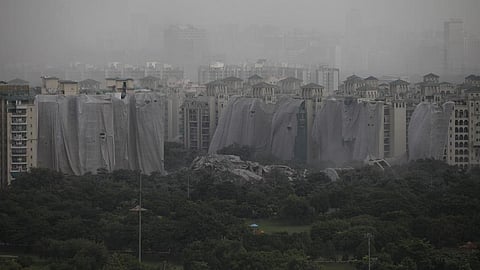Supertech: It is essential to mitigate pollution, waste post-demolition; here is why
The Supertech Twin towers in Sector 93A of Noida, Uttar Pradesh were demolished by controlled implosion at 2.30 pm August 28, 2022. Their being located in a residential neighbourhood of Noida makes it even more essential to introduce interventions to mitigate pollution and waste, post-demolition.
The operation was carried out by Edifice Engineering based in Mumbai and South African company Jet Demolition. The demolition was done by a method known as the ‘waterfall technique’ to minimise damage to the surroundings.
But the demolition has resulted in 80,000 tonnes of construction and demolition (C&D) waste. Some 50,000-55,000 tonnes will be used for filling the site and dumped at designated areas. The rest will be sent to a C&D plant for processing.
This demolition has also produced large amounts of dust. Heavier dust particles will settle down soon but the light particulate matter (PM) will probably remain in the air for weeks.
The settling of the dust particulate will also depend on wind speed and wind direction. Dust will also remain in the air because of loading and unloading of trucks for clearing the debris.
The Air Quality Index (AQI) bulletin issued by the Central Pollution Control Board at 4 pm August 28 mentioned Noida’s AQI to be at 120. This is considered to be ‘moderate’. Delhi, located just across the Yamuna, had an AQI of 119, which is also categorised as ‘moderate’.
However, a more detailed analysis of pollutants and chemicals should be done to understand the health hazards of such a large-scale demolition by explosives. The immediate vicinity of the site after the demolition witnessed a huge cloud of dust, which spread to a vast area soon.
There are various health effects that can befall people in the vicinity like respiratory issues, skin ailments, as well as allergic disorders. There is an increase in lead, silica and asbestos in the atmosphere and a tremendous amount of PM10 and PM2.5 particles.
Increased lead exposure may lead to headache, tiredness, irritability and constipation, silicosis, etc. Silt accumulation in drainage systems can lead to problems like water-borne and parasite diseases.
On the job
The Noida Authority has been reported to have provided water tankers, mechanical sweeping machines and sanitation staff, as well as air quality monitoring at and near the building site.
Anti-smog guns and water sprinklers have been in use in the area after the demolition to minimise the spread of PM in the atmosphere.
Dust machines have been installed at the site for monitoring pollution levels after the demolition. Layers of tarpaulin, synthetic sheets and protective covering material have also been put on each floor of the towers by the demolition team to minimise the impact of dust, noise and vibrations.
The Noida Authority is also monitoring AQI levels post-demolition. The concerned authorities had given an NOC for the demolition to go ahead and post the demolition, the standard protocols for disposal of debris will be followed according to The Construction and Demolition Waste Management Rules, 2016.


